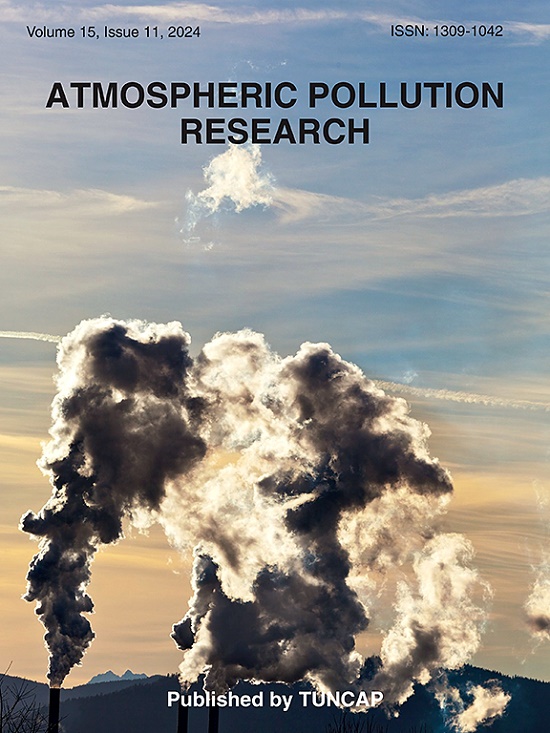Impact of military activity on atmospheric aerosol characteristics in Ukraine and Kyiv city
IF 3.9
3区 环境科学与生态学
Q2 ENVIRONMENTAL SCIENCES
引用次数: 0
Abstract
We investigate the impact of the Russian invasion and military activities on aerosol parameters and air quality in the atmosphere over Kyiv and Ukraine. This study analyzes changes in pollutants such as black carbon, particulate matter PM2.5 and PM10, and sulfates (SO2 and SO4) using MERRA-2 reanalysis data. Black carbon concentration surged in eastern and western Ukraine during pre-invasion times, attributed to industrial emissions and solid fuel heating. During invasion, black carbon levels decreased overall, except in conflict-affected areas like Kyiv and southeastern regions, reflecting reduced industrial activities in the battle region. Similarly, PM2.5 levels increased in eastern conflict zones, correlating with military intensity. Shifts in SO2 and SO4 concentrations indicated increased emissions in southeastern Ukraine due to military activities and infrastructure damage. Also, this research aims to analyze aerosol properties using AERONET data. Sun photometer observations reveal changes in the annual dynamics of the Ångstrom exponent, with lower values observed in 2022 and a decrease in the fine aerosol fraction. Analysis of the aerosol complex refractive index and single scattering albedo indicate a shift in the dominant aerosol type present in the atmosphere in 2022–2024. According to the GRASP algorithm, a significant increase in the black carbon fraction was registered in 2022. Air contamination in Kyiv through PM2.5 and PM10 in 2021 and 2022 revealed substantial increases during critical conflict periods attributed to military actions. Despite initial declines just after the invasion, PM levels remained elevated compared to pre-invasion years, indicating ongoing air quality challenges exacerbated by war-related factors.

军事活动对乌克兰和基辅市大气气溶胶特征的影响
我们调查了俄罗斯入侵和军事活动对基辅和乌克兰上空大气中的气溶胶参数和空气质量的影响。本研究使用MERRA-2再分析数据分析了黑碳、颗粒物PM2.5和PM10以及硫酸盐(SO2和SO4)等污染物的变化。在入侵前,乌克兰东部和西部的黑碳浓度激增,原因是工业排放和固体燃料加热。在入侵期间,除了基辅和东南地区等受冲突影响的地区外,黑碳水平总体下降,反映出战区的工业活动减少。同样,东部冲突地区的PM2.5水平也在上升,与军事强度相关。SO2和SO4浓度的变化表明,由于军事活动和基础设施破坏,乌克兰东南部的排放量增加。此外,本研究旨在利用AERONET数据分析气溶胶特性。太阳光度计观测揭示了Ångstrom指数的年动态变化,2022年观测到的数值较低,细气溶胶部分减少。对气溶胶复折射率和单散射反照率的分析表明,2022-2024年大气中主要气溶胶类型发生了变化。根据GRASP算法,在2022年,黑碳分数显著增加。2021年和2022年基辅的PM2.5和PM10空气污染在军事行动导致的关键冲突期间大幅增加。尽管入侵后不久就开始下降,但与入侵前相比,PM水平仍然较高,这表明与战争有关的因素加剧了持续的空气质量挑战。
本文章由计算机程序翻译,如有差异,请以英文原文为准。
求助全文
约1分钟内获得全文
求助全文
来源期刊

Atmospheric Pollution Research
ENVIRONMENTAL SCIENCES-
CiteScore
8.30
自引率
6.70%
发文量
256
审稿时长
36 days
期刊介绍:
Atmospheric Pollution Research (APR) is an international journal designed for the publication of articles on air pollution. Papers should present novel experimental results, theory and modeling of air pollution on local, regional, or global scales. Areas covered are research on inorganic, organic, and persistent organic air pollutants, air quality monitoring, air quality management, atmospheric dispersion and transport, air-surface (soil, water, and vegetation) exchange of pollutants, dry and wet deposition, indoor air quality, exposure assessment, health effects, satellite measurements, natural emissions, atmospheric chemistry, greenhouse gases, and effects on climate change.
 求助内容:
求助内容: 应助结果提醒方式:
应助结果提醒方式:


